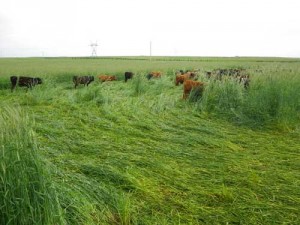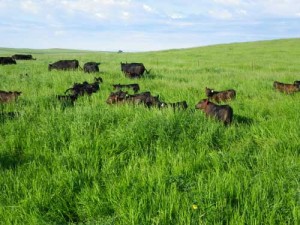As our operation has and continues to evolve, we have changed the way that we graze our livestock. During the grazing season we used to look at three things: the cows, the grass, and the water. By utilizing the principles of Holistic Management, we now look at the “whole” rather than just these three things or “parts.” Now we realize that livestock are merely just a tool (and a good one at that) for achieving a greater goal for our operation. Our land base is regenerating and greatly improving. When we as ranchers say that “the cows are out grazing,” there is much more going on out there than we realize. This is why it is important to take note of everything going on out in the pasture. The list could be endless, but some to think about include: soil health, forage height, leaf density, sward thickness, plant species diversity, plant maturity, ground cover, graze: trample ratio, wildlife, insects, water, and livestock. These are things that are visually taken into account every time our cows are grazing.
Our previous grazing strategy consisted of a few pastures that the cattle were simply rotated through every few weeks. Although this was better for the “whole” than continuous grazing, it still wasn’t taking our land-base in the right direction. Twenty years ago we started rotational grazing with an understanding of the principals of rest/recovery. While learning about Holistic Management, an emphasis is put on animal impact and getting residue in contact with the soil surface. There are billions of mouths to feed below the soil surface and we need to feed them. This can easily be achieved by having a diverse plant community that supplies them with food via root exudates, as well as having the cattle put residue on the soil surface, which provides countless benefits to the health of the ecosystem. In order to get the livestock to be both efficient at consuming forage and trampling residue (carbon) onto the soil surface high stock densities are needed. We typically like the cattle to consume 30-40% of the aboveground biomass and trample the majority of the remaining sward. We typically move the cowherd once a day and the yearling herd anywhere from 3-7 times a day. This may sound like a lot of work, but as in any situation, the human mind can make it as easy or complex as it wants. We chose the easy way The majority of our permanent pastures are 15-40 acres in size. Every morning portable fence is set up to divide these pastures even further. These temporary paddocks range in size from 1/6 of an acre to 2 acres to give us the stock density we desire. The use of solar-powered automatic gate openers made this an easy daily routine. A time was preset into each of the gate openers and the cattle moved themselves into the next temporary paddock throughout each day. Talk about stress-free for both the cattle and people. When mob grazing we typically use stock densities around 700,000 pounds of liveweight/acre. With this type of density we were able to achieve maximum ground cover due to the trampling caused by animal impact. We noticed that the pastures that were mob grazed fully recovered on average a week or two faster than those that were MIG grazed. It is important to note that we do not always move the cattle at this frequency. Whenever we want to take a vacation or some time off we simply allow them a larger paddock. This allows us the Quality of Life we desire.
Since we have incorporated a planned grazing strategy, the flexibility and options that we have on when and where to move the livestock has greatly increased. This is especially important because we rely on this flexibility and nature for fly and parasite control. We quit using insecticides (pour-ons, fly tags, and orals) many years ago and have since seen a large increase in dung beetle and insect predator populations. Cowbirds are also found patrolling the herd year-round. Their numbers coincide with fly populations throughout the year. They, along with being able to move the livestock away from fly pressure and grazing tall have done an excellent job of controlling flies and parasites. We don’t want to completely eliminate flies, but rather obtain a balance between predator and prey. Keeping a fly population is essential for us to see which genetics are naturally more fly-resistant. Although we do not specifically use fly-resistance as a selection tool, it is taken into consideration when we decide which animals to keep as replacements.
Another of the many benefits of high stock densities is that it allows us to use the cattle to control noxious weeds. We were able to rent some land that had been in CRP for twenty years. It was primarily composed of smooth bromegrass, a small amount of alfalfa and quite a large extent of noxious weeds. By running higher stock densities cattle behavior changes and, although they are not forced to, they readily consume less desirable species such as Canada thistle. We have been able to greatly reduce the infestations of noxious weeds, while at the same time, increase the diversity and health of other grasses and forbs in these pastures. Along with Canada thistle, our cattle are now grazing absinth wormwood and leafy spurge.
It has been a joy to see the improvement in our grazing resources and we feel we have just begun. We owe a great deal of gratitude to all who have been both an inspiration and a help to us, especially Ken Miller, Jonathan Lundgren and Neil Dennis. We invite you to check our Facebook page to follow our grazing throughout the year.

